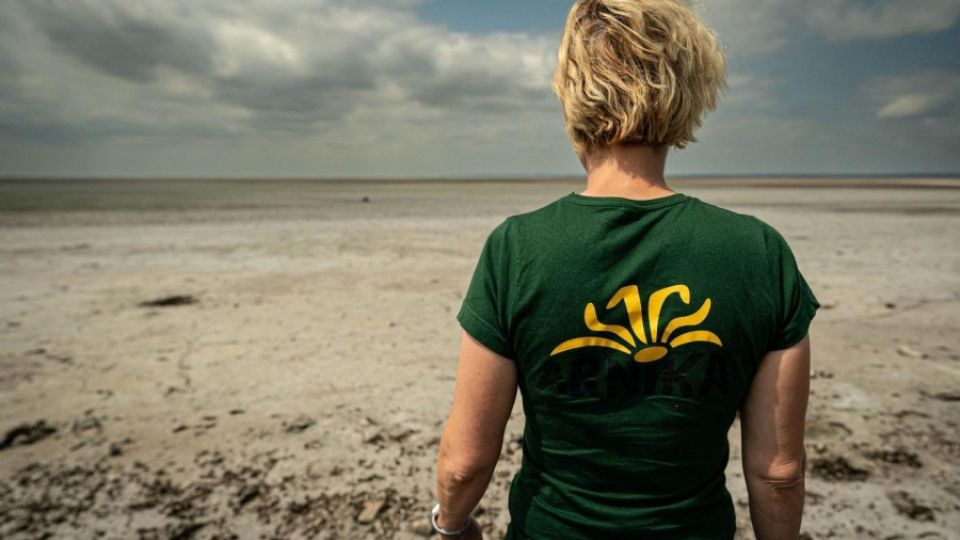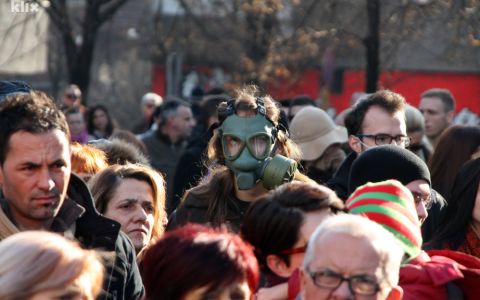On 6 June 2023, the Kakhovka dam in Ukraine's was destroyed, representing one of the most serious environmental disasters caused by the Russian invasion of the country. The resulting floodwaters inundated human dwellings, forests, and agricultural land, killing tens of thousands of tonnes of fish and destroying important habitats. Civil society organizations warn that these environmental impacts must be included in the planning of Ukraine's post-war reconstruction.
The dam's outflow left behind a dry bed spanning approximately 2,000 km², which has accumulated hazardous substances from decades of intensive farming and industrial activities. In cooperation with Ukrainian civil society organisations and the Dekonta company, the Czech NGO Arnika collected a total of fourteen samples from the bottom of the former reservoir and adjacent sites in 2023. Both the sediment from the dry bed and multiple soil samples from Russian missile craters were then tested for a range of contaminants, including pesticides, heavy metals, petroleum hydrocarbons, and persistent chemicals.
Shocking amounts of toxic substances in sediments
The results of the analysis carried out in July 2023 are alarming. High levels of the banned pesticide DDT were found in samples taken from Zaporizhzhia's town beach. HCH (hexachlorocyclohexane), another dangerous insecticide, was also present. These concentrations suggest proximity to a heavily contaminated site, such as an old pesticide dump, or long-term deposition during the era of intensive Soviet agriculture.
Some of the sediments contained polycyclic aromatic hydrocarbons, including the highly carcinogenic benzo[a]pyrene, at concentrations thousands of times higher than the Czech Republic's soil decontamination limits. Elevated concentrations of mineral oils, which are typical of historic heavy industry, were also detected in the sediments. High levels of heavy metals, particularly arsenic, manganese and chromium, as well as PCBs (polychlorinated biphenyls), were found at the confluence of the Sukhaya Moskovka River and the Dnieper, which is indicative of past industrial pollution.
Serious risk to public health
Oleksiy Angurets of the Clean Air for Ukraine project described the quantity of toxic substances found as "shocking", warning that the contaminated sediments could pose a significant threat to local residents. If these contaminants were to enter the food chain, for example by growing vegetables on contaminated land, it would pose a serious health risk.
Several of the substances found, such as DDT and other banned pesticides, as well as PCBs, are persistent organic pollutants. These substances break down very slowly in nature, meaning they accumulate in sediments and animal organisms. Although most of these substances were banned long ago, they remain in the environment for decades. Published analyses have shown that concentrations of DDT in some sediments significantly exceed safety limits, as do concentrations of other toxic substances. This confirms that pollution levels are approaching those requiring expert decontamination.
Armed conflict revealed hidden ecological burdens
“The war is exacerbating the ecological risks that were already present,” warns Marcela Černochová, Arnika's coordinator for Ukraine currently attending an event in Kherson, Ukraine, focused on discussion of the future of Kakhovka. She adds that the remediation of ecological damage must form an integral part of Ukraine's post-war reconstruction plans. While Russian aggression has devastated infrastructure, it has also exposed hidden toxic substances. Therefore, when planning reconstruction, it is crucial to consider monitoring and removing soil and water pollution, as without this, it will be impossible to safeguard public health and rebuild the affected regions.
“Even in today's turbulent times, discussions about the future of Kakhovka are ongoing. The questions being debated include whether to build a new reservoir, restore the natural ecosystems or find some middle ground. For instance, there has been talk of planting trees for bioenergy purposes, given that the bottom of the reservoir is already covered in dense willow growth. However, the toxic substances present at the bottom of the reservoir pose various risks. Contaminants stored in the deeper layers of sediment have already migrated to the upper layers and vegetation, indicating a clear risk of further spread,” Černochová adds.
Arnika is therefore appealing to the Czech authorities and the general public not to overlook the ecological dimension of the conflict when supporting Ukraine. Alongside the reconstruction of houses and infrastructure, long-term monitoring and remediation of undetected environmental damage must be ensured. Only consistent environmental care can protect the health of the local population and restore the affected areas.
Arnika's long-term activities in Ukraine
Arnika has been working in Ukraine since 2017, when it launched the 'Clean Air for Ukraine' programme in collaboration with local partners. This programme aims to establish a network of citizen-run monitoring stations that measure air quality in real time. EcoCity's network of over 700 stations has become a vital source of information on air pollution, particularly in areas affected by the war. However, the conflict has damaged and destroyed some of these stations, prompting Arnika to work to restore and expand the network to other regions, ensuring citizens have access to up-to-date air quality data.
Following the Russian invasion in 2022, Arnika expanded its activities in Ukraine to include providing humanitarian aid and monitoring the environmental impact of the war. The organisation provided material aid worth almost one million CZK and began researching the ecological impacts of the war, including analysing the sediments of the destroyed Kakhovka Dam. By collaborating with Ukrainian partners — namely the Free Arduino initiative in Ivano-Frankivsk and the Green World initiative in Dnipro — Arnika has been able to map soil and water contamination and highlight health risks to the population.
The sediment analysis was developed as part of Arnika's long-term collaboration with Ukrainian partners on the "Clean Air for Ukraine" project. The collection and la boratory processing of the samples was enabled by financial support from the Transition Promotion Programme of the Ministry of Foreign Affairs of the Czech Republic and the Swedish Development Fund enabled the collection and laboratory processing of the samples.
The full study of the sediment of the former Kakhovka dam can be found here: https://arnika.org/en/publications/first-research-of-the-contamination-of-the-sediments-from-kakhovka-reservoir-extended-version

(For more information, please contact Marcela Černochová, Arnika's Project Coordinator in Ukraine (This email address is being protected from spambots. You need JavaScript enabled to view it.)







